Research Needs Identified for Potential Effects of Energy Development Activities on Environmental Resources of the Williston Basin, United States
Links
- Document: Report (1.84 MB pdf) , HTML , XML
- Download citation as: RIS | Dublin Core
Introduction
Unconventional oil and gas (UOG) development that uses horizontal drilling and hydraulic fracturing has changed the landscape and exponentially increased oil production within the Williston Basin (Post van der Burg and others, 2022b), especially in North Dakota and eastern Montana (fig. 1). The activities and potential effects associated with UOG development are complex and wide reaching and include, in part, road and well-pad construction, leaks from pits or tanks, chemical spills, discharge of wastewater, drilling before casing installation, leaks during or after hydraulic fracturing, failed casing seals, pipeline breaks, abandoned wells, deep-well disposal of flowback or produced wastewater, and induced subsurface migration pathways that can potentially adversely affect the environmental resources within the Williston Basin (fig. 2).
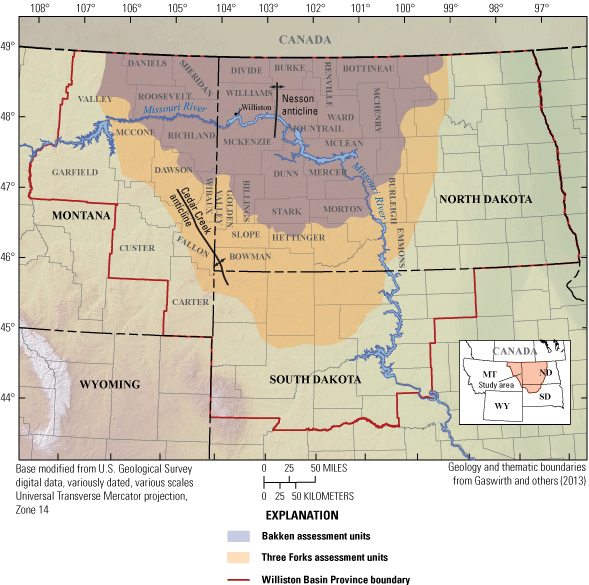
Boundaries of the Williston Basin Province and the Bakken and Three Forks assessment units within the United States (data from Gaswirth and others [2013]; modified from McShane and others [2020]).
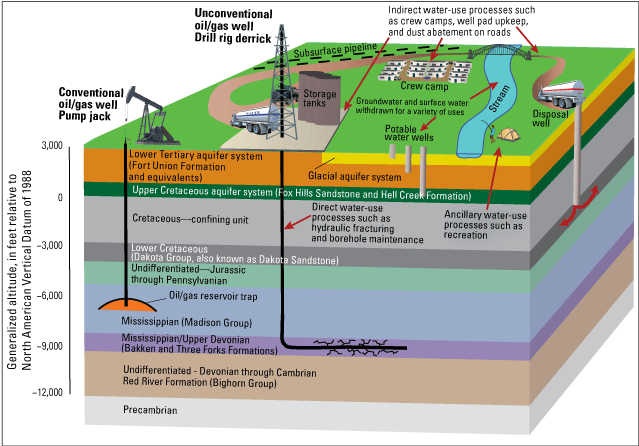
Schematic showing the various conventional and unconventional oil and gas development activities in the Williston Basin (modified from Carter and others [2016]).
Although research on the environmental consequences of UOG development in the Williston Basin has begun, research has been limited in scope and relatively autonomous with respect to the full range of environmental considerations that warrant study. These considerations include, in part, water quality, water availability, ecological effects, and the effects on ecological and human health. Unbiased, interrelated, and integrated scientific investigations are needed to help key resource managers make informed decisions.
Within the Williston Basin, a group of Federal agencies continue to develop coordination strategies for numerous energy-related issues on Federal lands. This group, the Bakken Federal Executive Group (BFEG), has representation from the U.S. Department of the Interior, U.S. Geological Survey (USGS), Bureau of Land Management, Bureau of Indian Affairs, U.S. Forest Service, National Park Service, U.S. Fish and Wildlife Service, Bureau of Reclamation, U.S. Army Corps of Engineers, U.S. Environmental Protection Agency, and the U.S. Department of Agriculture.
To aid the BFEG efforts, a study was recently (2022) completed by the USGS in cooperation with the Bureau of Land Management to provide a summary of the best available scientific information to support documentation of potential effects on the environmental resources that Federal agencies manage (Bartos and others, 2022; Post van der Burg and others, 2022a, b; Vining and others, 2022). This study focused on a prioritized list of information needs elicited from the BFEG group and identified key information and research needs to better inform decisions for those involved directly in managing energy development and resources on public land.
Why Is This Information Important? Who Cares?
The primary report referenced herein, the Bakken Environmental Status and Trends report, was developed in collaboration with the Bakken Federal Executive Group to better inform environmental management decisions related to energy development in the Williston Basin. The Bakken Environmental Status and Trends report consists of four chapters: chapter A provides an executive summary (Post van der Burg and others, 2022b); chapter B provides a description of physiography, climate, land use, and demographics (Vining and others, 2022); chapter C describes water resources (Bartos and others, 2022); and chapter D focuses on species of conservation concern (Post van der Burg and others, 2022a). These decisions included actions related to environmental compliance, permitting, and leasing and how to engage with other State and Federal agencies. This fact sheet highlights specific research needs identified in the primary report and several independent U.S. Geological Survey workshops, which also will aid in contributing to better informed environmental management decisions.
Research Needs in the Williston Basin
The research needs identified from an extensive review of the potential effects of energy development activities on the environmental resources of the Williston Basin have been summarized. These needs, as described herein, focus on the following categories:
-
Water quality and availability,
-
Characterization of ecological effects to inform decision support tools, and
-
Effects on aquatic species and human health.
Although these topics are described separately, it is essential to stress the importance of a systematically determined, unbiased, and integrated research strategy to satisfy these complex research needs.
Water Quality
Water-quality degradation from UOG development is most likely to result from accidental releases of produced water and chemicals at the land surface or leakage through the casing or annular space of incompletely sealed oil/gas wells in the subsurface (Vidic and others, 2013; California Council on Science and Technology, 2014; Council of Canadian Academies, 2014; Vengosh and others, 2014; U.S. Environmental Protection Agency, 2016). Chemicals used in drilling and hydraulic-fracturing processes, hydrocarbons and formation water produced from oil and gas wells, and mixtures of these fluids contain many chemicals that could degrade groundwater and surface-water quality. However, only a relatively small number of these chemicals have been studied in groundwater or surface water. Moreover, publicly available data that thoroughly characterize the chemical and isotopic composition of produced and flowback water from UOG wells are limited. Those data are crucial for recognizing mixing between groundwater/surface water and UOG-related fluids.
Many of the research needs associated with water quality are associated with proper planning and the development of a research strategy. This strategy needs to be complementary of the research needs of other disciplines to maximize the utility and usefulness of subsequently collected data. More specifically, research in this area should be integrated with research related to ecological effects and the effects on ecological and human health. As part of this research strategy, specific needs include the following:
-
Systematically determining specific UOG-related chemicals to monitor in groundwater and surface water. This may require the development of new analytical techniques for chemicals that currently cannot be measured or have high detection levels. As part of this effort, the chemical and isotopic composition of produced and flowback water from UOG wells needs to be better characterized to recognize mixing between groundwater/surface water and oil field waters released to the environment from surface or subsurface sources.
-
Systematically identifying specific sampling locations and sampling frequency to account for spatial (baseline conditions) and temporal components, as well as consistent sampling and analytical techniques. These techniques should be consistent with techniques from other plays or they should serve as the basis for other plays to follow. Sampling locations and frequency should consider proximity to current and future UOG infrastructure and processes to capture information along a gradient of UOG development intensity.
-
Focusing initial groundwater emphasis on shallow groundwater that may be affected more easily in comparison to deeper groundwater systems. Shallow groundwater also may be hydraulically connected to important wetlands (fig. 3) that also need monitoring.
-
Focusing initial surface-water emphasis on rivers/streams and reservoirs considered to be the most important and vulnerable from a human and ecological health perspective.
-
Completing a basinwide, systematically determined assessment of the subsurface by an airborne electromagnetic electrical conductivity survey (and other geophysical techniques) to characterize the current state of salinization that may be due to produced-water releases. This will help to identify potential groundwater sampling sites. This approach also will aid in identifying potential areas of water-resource vulnerability, especially when combined with the location of infrastructure used to transport produced water and oil.
-
Finally, installing continuous water-quality monitors for select indicator constituents to potentially determine spills on a real-time basis.
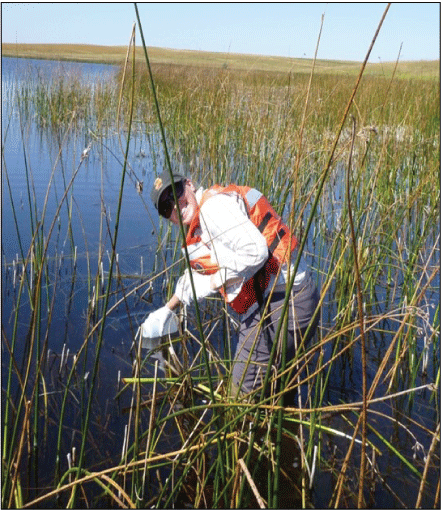
Water-quality sampling in a wetland (photograph by Tara Chesley-Preston, U.S. Geological Survey).
Water Availability
Water availability and the potential for reduction in aquifer storage volumes are important considerations in UOG settings. Long-term energy development requires sources of high-quality, sustainable water supplies and updated information about water use. Groundwater and surface-water availability must be evaluated and quantified to determine if the water sources can meet the needs of the energy development. Key components to consider when evaluating water sources for any type of energy development are water withdrawals (and returns) and consumptive use. Large volumes of water are used for oil well development and maintenance, as well as ancillary uses such as for dust suppression (fig. 4). It is important to understand the sources of these large volumes of water in consideration of other water needs that rely on the same sources of water for non-UOG development purposes. More specifically, an accurate and complete water budget is needed to fully understand water use associated with UOG development in the Williston Basin in the context of all water use.
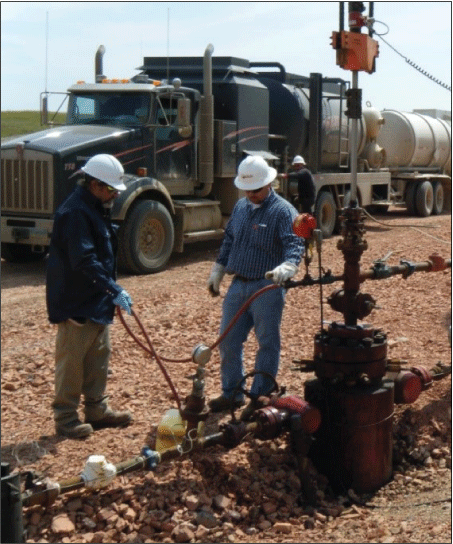
Collection of a produced-water sample. A truck injecting fresh water into an oil well for routine maintenance is shown in the background (photograph by Joanna Thamke, U.S. Geological Survey).
Two completed studies highlight water availability in the Williston Basin. The first study assessed groundwater availability in the Williston Basin. Initial steps of this assessment included development of a three-dimensional hydrogeologic framework (Thamke and others, 2014) and a conceptual model of the three uppermost principal aquifer systems (Long and others, 2014) used to supply potable groundwater. Using these results, a numerical groundwater-flow model was developed to aid in understanding stresses on the groundwater system composed of the aquifer systems and assess changes in the groundwater budget and groundwater levels that might result from human activity and climate variability (Davis and Long, 2018a, b, c; Long and others, 2018). The second study estimated direct, indirect, and ancillary water use associated with development of continuous oil and gas resources in the Williston Basin in North Dakota and Montana (Carter and others, 2016; Valder and others, 2018, 2019; McShane and others, 2020). Water-use data and models derived from this study were used to refine the methods of compiling water-use data as part of the USGS’s 5-year national water-use estimates (https://www.usgs.gov/mission-areas/water-resources/science/water-use-united-states). Additional research needs to improve understanding of water availability include, in part, the following:
-
Developing a groundwater-storage reference gravity station network for monitoring long-term groundwater-storage changes in locations of primary interest.
-
Improving potentiometric-surface maps for glacial units.
-
Creating uniform stream network digital geographic coverages.
-
Improving information collected on ice-jam flooding.
-
Improving understanding of the cumulative effects of stock and diversion dams.
Characterize Ecological Effects to Inform Decision Support Tools
One of the primary questions surrounding the management of biological resources in the Williston Basin is how the incremental effect of individual energy development projects accumulates in the context of ongoing landscape change. Because of the complexity of this issue, large-scale spatiotemporally replicated studies that evaluate oil and gas extraction in concert with other stressors or replicated before-after control-effect studies are critical for resource managers to develop plans for minimizing negative effects to ecological systems and the species they support. Distributional models would be valuable tools to assess cumulative and spatially distributed effects; however, because of the amount of effort required to develop these models, managers would need to prioritize which species and ecological endpoints would benefit the most from more indepth modeling. The end goal of such modeling efforts should not only be to simply predict species effects and distributions, but also should be to analyze scenarios and management strategies and help inform and establish long-term, multispecies, spatially extensive ecological monitoring programs.
Research needs are largely associated with the development of decision support tools for planning projects that minimize the cumulative effects of UOG development on species and ecosystems. Much of the research in this area should be closely associated with research related to water quality and the effects on ecological and human health. Research needs to enhance the development of decision support tools include the following:
-
Obtaining more data on species distribution and species-specific effects of UOG development.
-
Obtaining more information about other landscape stressors, such as the effects of agricultural development on species populations, to put UOG development in a landscape multistressor context.
-
Developing systematically determined, landscape-scale datasets that could be used to predict the distribution for species of concern. These datasets need to be developed at a scale sufficient to inform management decisions.
-
Obtaining more detailed data on certain taxa and select species. These data include, but are not limited to, a systematic baseline inventory of plant and appropriate terrestrial and aquatic species and a system of monitoring select species to assess temporal trends and spatially distributed effects.
-
Improving understanding on how ancillary UOG threats (for example, light, dust, roads, and noise) affect ecosystem processes and a wide range of taxa. Among these threats, birds and mammals are currently the most commonly studied, although substantial information gaps exist. Other species, including insect pollinators, reptiles, and amphibians, are almost entirely unstudied to date (as of 2022).
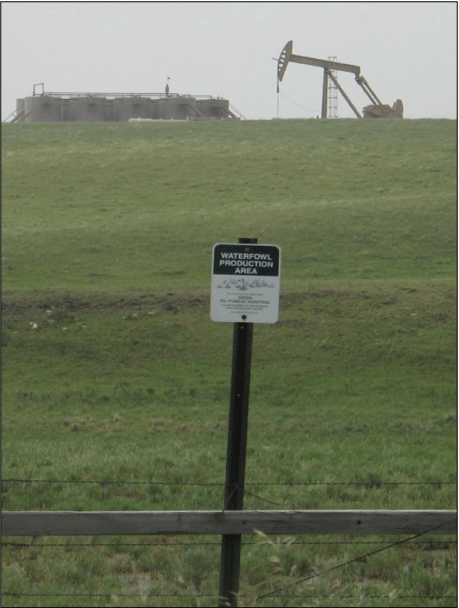
The effects of unconventional oil and gas development on ecological systems need consistent and long-term monitoring that is integrated with other science disciplines (photograph by Max Post van der Burg, U.S. Geological Survey).
Effects on Aquatic Species and Human Health
Conventional and UOG development pose unknown risks to the quality of atmospheric, groundwater, surface-water, soil, and other environmental resources. These emerging risks need to be examined because of their potential effects on ecological and human health. The rapid pace of UOG development has brought these issues to the forefront of the national conversation about the role of oil and gas development on health (Post van der Burg and others, 2022a). Primary public concerns include contamination of water from drilling operations, injection of chemicals into the ground, and release of chemicals from wastewater spills (fig. 2; National Academy of Sciences, Engineering, and Medicine, 2015). Potential effects can occur throughout the life cycle of UOG development and by multiple environmental pathways. Effects to species that inhabit prairie pothole wetlands and low-order drainage streams are of distinct concern, especially in the Williston Basin.
Research in this area should be inextricably associated with research related to water quality and ecological effects. Research needs include, in part, the following:
-
Developing a more comprehensive understanding of the fate and reactivity of constituents released into the environment from UOG activities.
-
Designing and executing additional site-based and process-oriented studies that quantify geochemical alterations of water, soil, wetland, and sediment samples from UOG wastewater-affected sites.
-
Emphasizing and improving the understanding of the occurrence of contaminants of aquatic and human-health concern.
-
Emphasizing and improving the understanding of the occurrence of contaminants that could serve as useful tracers of waste materials in the event of a release to the environment.
-
Completing comprehensive toxicity analyses for a range of native aquatic invertebrates, fish, and mussels to identify potential negative effects of produced water and oil spills. Currently (2022), there is an almost complete lack of ecosystem and field-based assessments of toxicity that is focused on multispecies mortality.

The availability of high-quality water is critical for many purposes, including ecological and human health (photograph by Gregory Delzer, U.S. Geological Survey).
References Cited
Bartos, T.T., Sando, S.K., Preston, T.M., Delzer, G.C., Lundgren, R.F., Nustad, R.A., Caldwell, R.R., Peterman, Z.E., Smith, B.D., Macek-Rowland, K.M., Bender, D.A., Frankforter, J.D., and Galloway, J.M., 2022, Potential effects of energy development on environmental resources of the Williston Basin in Montana, North Dakota, and South Dakota—Water resources (ver. 1.1, October 2022): U.S. Geological Survey Scientific Investigations Report 2017–5070–C, 159 p., accessed November 20, 2022, at https://doi.org/10.3133/sir20175070C.
California Council on Science and Technology, 2014, An independent scientific assessment of well stimulation in California: Sacramento, Calif., California Council on Science and Technology, 371 p., accessed September 13, 2017, at https://ccst.us/publications/2015/2015SB4-v1.php.
Carter, J.M., Macek-Rowland, K.M., Thamke, J.N., and Delzer, G.C., 2016, Estimating national water use associated with unconventional oil and gas development: U.S. Geological Survey Fact Sheet 2016–3032, 6 p. [Also available at https://doi.org/10.3133/fs20163032.]
Council of Canadian Academies, 2014, Environmental impacts of shale gas extraction in Canada: Ottawa, Ontario, Council of Canadian Academies, 262 p., accessed June 22, 2022, at https://oilandgasinfo.ca/wp-content/uploads/2017/11/Environmental-Impacts-of-Shale-Gas-Extraction-in-Canada.pdf.
Davis, K.W., and Long, A.J., 2018a, Construction and calibration of a groundwater-flow model to assess groundwater availability in the uppermost principal aquifer systems of the Williston Basin, United States and Canada: U.S. Geological Survey Scientific Investigations Report 2017–5158, 70 p., accessed November 20, 2022, at https://doi.org/10.3133/sir20175158.
Davis, K.W., and Long, A.J., 2018b, MODFLOW-NWT model of predictive simulations of groundwater response to selected scenarios in the Williston Basin, United States and Canada: U.S. Geological Survey data release, accessed November 20, 2022, at https://doi.org/10.5066/P9FACTT3.
Davis, K.W., and Long, A.J., 2018c, MODFLOW-NWT model used to assess groundwater availability in the uppermost principal aquifer systems of the Williston structural basin, United States and Canada: U.S. Geological Survey data release, accessed November 20, 2022, at https://doi.org/10.5066/F75B01CZ.
Gaswirth, S.B., Marra, K.R., Cook, T.A., Charpentier, R.R., Gautier, D.L., Higley, D.K., Klett, T.R., Lewan, M.D., Lillis, P.G., Schenk, C.J., Tennyson, M.E., and Whidden, K.J., 2013, Assessment of undiscovered oil resources in the Bakken and Three Forks Formations, Williston Basin Province, Montana, North Dakota, and South Dakota, 2013: U.S. Geological Survey Fact Sheet 2013–3013, 4 p. [Also available at https://doi.org/10.3133/fs20133013.] [Supersedes USGS Fact Sheet 2008–3021.]
Long, A.J., Aurand, K.R., Bednar, J.M., Davis, K.W., McKaskey, J.D.R.G., and Thamke, J.N., 2014, Conceptual model of the uppermost principal aquifer systems in the Williston and Powder River structural basins, United States and Canada: U.S. Geological Survey Scientific Investigations Report 2014–5055, 41 p., accessed November 20, 2022, at https://doi.org/10.3133/sir20145055.
Long, A.J., Thamke, J.N., Davis, K.W., and Bartos, T.T., 2018, Groundwater availability of the Williston Basin, United States and Canada: U.S. Geological Survey Professional Paper 1841, 42 p., accessed November 20, 2022, at https://doi.org/10.3133/pp1841.
McShane, R.R., Barnhart, T.B., Valder, J.F., Haines, S.S., Macek-Rowland, K.M., Carter, J.M., Delzer, G.C., and Thamke, J.N., 2020, Estimates of water use associated with continuous oil and gas development in the Williston Basin, North Dakota and Montana, 2007–17: U.S. Geological Survey Scientific Investigations Report 2020–5012, 26 p., accessed November 20, 2022, at https://doi.org/10.3133/sir20205012.
National Academy of Sciences, Engineering, and Medicine, 2015, Chemistry and engineering of shale gas and tight oil resource development—Workshop in brief: Washington, D.C., The National Academies Press, 16 p., accessed June 22, 2022, at https://doi.org/10.17226/21882.
Post van der Burg, M., Symstad, A.J., Igl, L.D., Mushet, D.M., Larson, D.L., Sargeant, G.A., Harper, D.D., Farag, A.M., Tangen, B.A., and Anteau, M.J., 2022a, Potential effects of energy development on environmental resources of the Williston Basin in Montana, North Dakota, and South Dakota—Species of conservation concern: U.S. Geological Survey Scientific Investigations Report 2017–5070–D, 41 p., accessed November 20, 2022, at https://doi.org/10.3133/sir20175070D.
Post van der Burg, M., Vining, K.C., and Frankforter, J.D., 2022b, Potential effects of energy development on environmental resources of the Williston Basin in Montana, North Dakota, and South Dakota—Executive summary: U.S. Geological Survey Scientific Investigations Report 2017–5070–A, 7 p., accessed November 20, 2022, at https://doi.org/10.3133/sir20175070A.
Thamke, J.N., LeCain, G.D., Ryter, D.W., Sando, R., and Long, A.J., 2014, Hydrogeologic framework of the uppermost principal aquifer systems in the Williston and Powder River structural basins, United States and Canada (ver. 1.1, December 2014): U.S. Geological Survey Scientific Investigations Report 2014–5047, 38 p., accessed November 20, 2022, at https://doi.org/10.3133/sir20145047.
U.S. Environmental Protection Agency, 2016, Hydraulic fracturing for oil and gas—Impacts from the hydraulic fracturing water cycle on drinking water resources in the United States (final report): Washington, D.C., U.S. Environmental Protection Agency, EPA–600–R–16–236Fa, [variously paged], accessed December 13, 2016, at https://ordspub.epa.gov/ords/eims/eimscomm.getfile?p_download_id=530159.
Valder, J.F., McShane, R.R., Barnhart, T.B., Sando, R., Carter, J.M., and Lundgren, R.F., 2018, Conceptual model to assess water use associated with the life cycle of unconventional oil and gas development: U.S. Geological Survey Scientific Investigations Report 2018–5027, 22 p., accessed November 20, 2022, at https://doi.org/10.3133/sir20185027.
Valder, J.F., McShane, R.R., Barnhart, T.B., Wheeling, S.L., Carter, J.M., Macek-Rowland, K.M., Delzer, G.C., and Thamke, J.N., 2019, Analytical framework to estimate water use associated with continuous oil and gas development: U.S. Geological Survey Scientific Investigations Report 2019–5100, 19 p., accessed November 20, 2022, at https://doi.org/10.3133/sir20195100.
Vengosh, A., Jackson, R.B., Warner, N., Darrah, T.H., and Kondash, A., 2014, A critical review of the risks to water resources from unconventional shale gas development and hydraulic fracturing in the United States: Environmental Science & Technology, v. 48, no. 15, p. 8334–8348. [Also available at https://doi.org/10.1021/es405118y.]
Vidic, R.D., Brantley, S.L., Vandenbossche, J.M., Yoxtheimer, D., and Abad, J.D., 2013, Impact of shale gas development on regional water quality: Science, v. 340, no. 6134, p. 826–835. [Also available at https://doi.org/10.1126/science.1235009.]
Vining, K.C., Thamke, J.N., and Post van der Burg, M., 2022, Potential effects of energy development on environmental resources of the Williston Basin in Montana, North Dakota, and South Dakota—Physiography, climate, land use, and demographics: U.S. Geological Survey Scientific Investigations Report 2017–5070–B, 32 p., accessed November 20, 2022, at https://doi.org/10.3133/sir20175070B.
For more information about this publication, contact:
Director, USGS Dakota Water Science Center
821 East Interstate Avenue, Bismarck, ND 58503
1608 Mountain View Road, Rapid City, SD 57702
605–394–3200
For additional information, visit: https://www.usgs.gov/centers/dakota-water
Publishing support provided by the
Rolla Publishing Service Center
Suggested Citation
Delzer, G.C., and Post van der Burg, M., 2023, Research needs identified for potential effects of energy development activities on environmental resources of the Williston Basin, United States: U.S. Geological Survey Fact Sheet 2022–3088, 6 p., https://doi.org/10.3133/fs20223088.
ISSN: 2327-6932 (online)
Study Area
| Publication type | Report |
|---|---|
| Publication Subtype | USGS Numbered Series |
| Title | Research needs identified for potential effects of energy development activities on environmental resources of the Williston Basin, United States |
| Series title | Fact Sheet |
| Series number | 2022-3088 |
| DOI | 10.3133/fs20223088 |
| Year Published | 2023 |
| Language | English |
| Publisher | U.S. Geological Survey |
| Publisher location | Reston, VA |
| Contributing office(s) | Dakota Water Science Center |
| Description | 6 p. |
| Country | United States |
| State | Montana, North Dakota, South Dakota |
| Other Geospatial | Williston Basin |
| Online Only (Y/N) | Y |
| Google Analytic Metrics | Metrics page |


